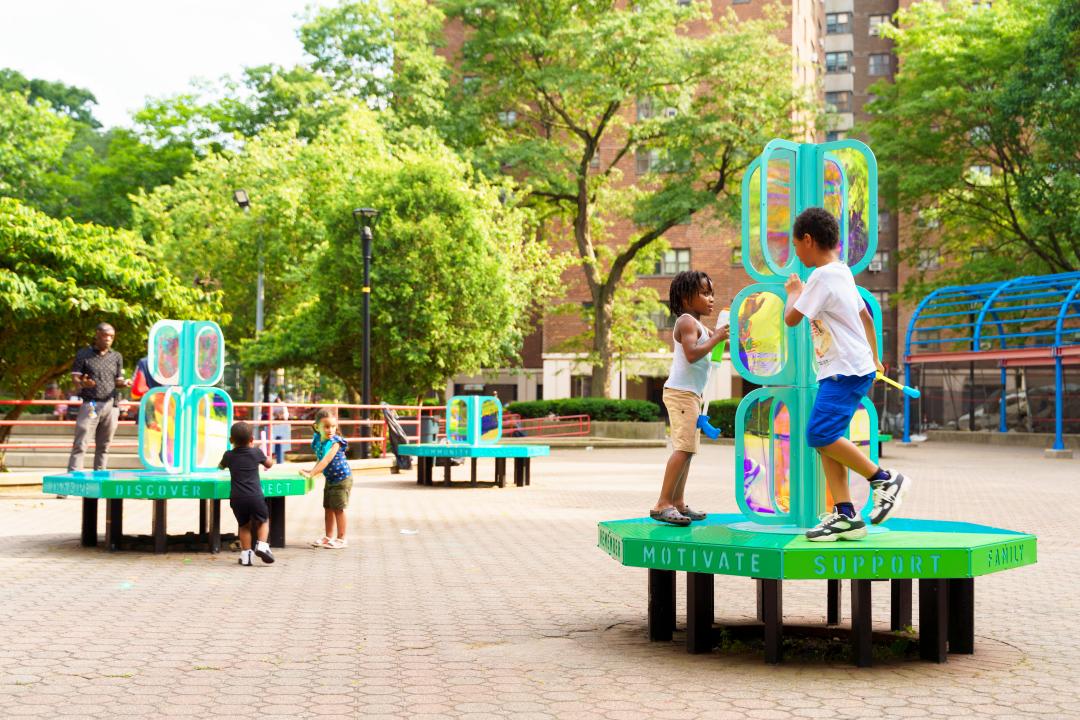The Harlem playground co-designed by public housing residents

Mars and the Moon Films
The Harlem playground co-designed by public housing residents
Kids on a playground.
A courtyard at Harlem’s Polo Grounds Towers, home to roughly 4,000 residents, was once characterized by several dilapidated wooden benches with remnants of red paint from years ago.
Now, after a four-month community design process to engage residents, the courtyard has been transformed into Sprout, a playscape created by and for the residents of the public housing development, Next City reports
Finished in June, Sprout features four bright green play structures built on the foundations of the old benches. Three of the four structures are clustered close together, with reflective leaf-like structures spinning out from their centers; the fourth is set apart and offers a quiet space for those who need it, part of an effort to make the playspace friendly for neurodiverse users.
“For me, my inner child absolutely came out when I saw my reflection in one of the mirrors,” says Serena Chandler, a longtime Polo Grounds resident and president of the towers’ tenant association. Chandler is also an original member of the towers’ Mayor’s Action Plan for Neighborhood Safety resident team.
Since its opening, some residents have tied balloons to the structures. Others have held birthday parties there. A space where residents used to have to bring their own chairs to gather is now an area where older residents can sit and chat while younger residents play.
“It was great to see the community come out,” says Ryan Swanson, who helped lead the design process. “But we already knew that was going to happen because when you do a [co-design] process … the community had a hand in building, designing, and making it.”
A Community’s Vision Sprouts to Life
Sprout was funded by a $30,000 payment from the Mayor’s Action Plan for Neighborhood Safety’s participatory budgeting initiative, which called for using space activation to enhance public safety. MAP began in 2014 as an effort to reduce crime across 30 of the New York City Housing Authority’s developments, working with neighborhood groups of residents like those at Polo Towers to define the safety issues most important to them.
The Center for Innovative Justice, a community justice organization in New York City that has partnered with MAP, introduced residents to The Urban Conga, a Brooklyn-based multidisciplinary design studio focused on open-ended play, as an option for bringing their vision to life.
“The community chose us, so we came in at that phase,” says Swanson, principal at The Urban Conga, of the co-design phase that took place in the months leading up to construction. “We started working with the community through a series of workshops to start designing the work.”
In many co-creation processes, it’s the loudest voices that get heard and considered. To disrupt the status quo, The Urban Conga used everything from dice rolls to kickstart conversations, to role play to help encourage new ideas, to maquettes that workshop attendees could play with and modify.
“We use play methodologies not only within our work, but within the process of creating our work,” explains The Urban Conga principal Maeghann Coleman, who led the playspace design along with Swanson.
The idea for a playscape with sprout-like elements that appear to be springing up from the ground came from a workshop in which many young residents began building palm trees growing out of the ground.
To make the budget stretch as far as possible, Coleman and Swanson decided to build on the foundations of the benches that were already there. While the wooden benches had decayed, the structures they sat on in the ground were made of sturdy steel. Reusing them avoided the hefty price tag that would come with constructing a new foundation, which often gives clients the impression that they didn’t get much bang for their buck when a good chunk of it was invested in underground supports.
To create a multisensory, neurodiversity-friendly experience, they used a variety of textures, from rough to soft and smooth, combined with calming blue and green colors to “enhance the element of a peaceful, calming environment,” Coleman says.
Because the spinning, leaf-like structures can be manipulated by those playing on the spaces, the elements of which look different depending on how light shines through them throughout the day, they encourage open-ended play—the ability to come back and have a new experience with the work each time.
“When talking with the community, they really wanted this project to be the beginning of more to come in the space,” Swanson recalls. Indeed, when Chandler visits the site today, what she sees is possibilities.
“I look at it every day and wonder how we could fix some lights to the bottom or do additional things that we might not have thought about at the beginning of the process,” she says. “It’s an inviting space where children with [neurodiversity] can come and feel comfortable.”
![]()
This story was produced by Next City, a nonprofit newsroom covering solutions for equitable cities, and reviewed and distributed by Stacker.
